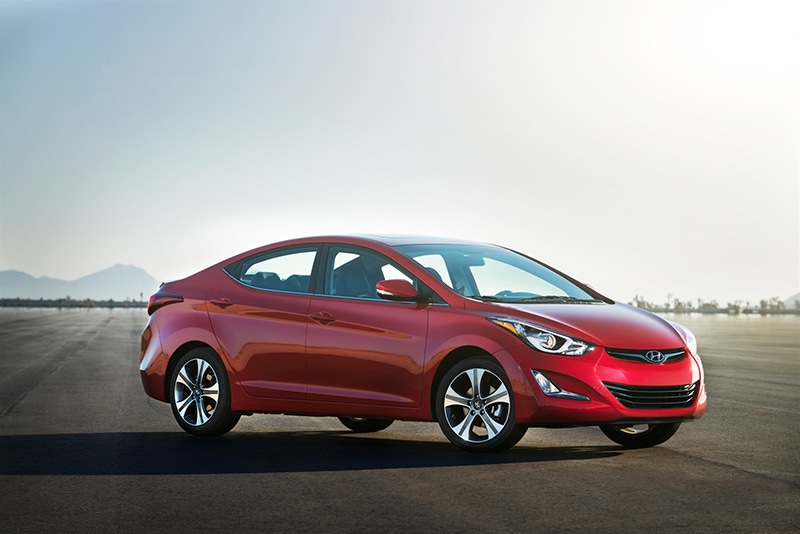Hyundai Unveils Tucson Fuel-Cell Vehicle, Refreshed Elantra in L.A.
The South Korean brand will lease the Tucson for $499 per month for 36 months to residents of Los Angeles and Orange counties.
November 20, 2013

Hyundai uses the Los Angeles auto show to unveil the U.S. version of its Tucson hydrogen fuel-cell vehicle and the refreshed ’15 Elantra compact car.
The Tucson HFCV, due to arrive in the U.S. in first-half 2014, follows the CUV’s launch this year in South Korea and Europe. However, the model is expected to beat rival cars from Honda and Toyota to market by roughly one year.
Despite the Tucson being a lease-only model, much like rival Honda’s FCX Clarity was at its launch in 2008, Hyundai Motor America CEO John Krafcik proclaims HFCVs as “more than marketing” gimmicks.
“They make sense, they really do,” he told media Nov. 15 at an L.A. auto show preview at Hyundai’s Superior Township, MI, technical center.
Hyundai is high on the Tucson FCV’s potential because “it’s got great range and I can refill it in almost no time,” Krafcik says, citing a refill time of 4 minutes.
The Hyundai U.S. chief notes 480V “quick” charging of electric vehicles takes a half-hour to fill the battery to 80% capacity.
“We really think (the Tucson HFCV) will make battery EVs feel old-fashioned,” he says.
The Tucson HFCV can travel up to 300 miles (483 km) on one tank of hydrogen, giving it a greater range than most EVs on the market today, which typically do less than 100 miles (62 km) on a full charge.
The CUV’s tank can hold 12.3 lbs. (5.6 kg) of hydrogen, and the vehicle can go 0-65 mph (0-105 km/h) in 12.5 seconds.
Output for the Tucson HFCV is rated at 100 kW (134 hp) and 221 lb.-ft. (300 Nm) of torque, compared with 182 hp and 177 lb.-ft. (240 Nm) in the standard gasoline-engine Tucson.
A small lithium-ion polymer battery will be part of the package at launch to assist the fuel cell during brisk acceleration. It also extends the vehicle’s range due to the relatively scant number of hydrogen refueling stations, says Mike O’Brien, vice president-corporate and product planning for HMA.
Because Southern California is home to the most hydrogen stations in the U.S., about 30 according to the California Fuel Cell Partnership, Hyundai will limit leases to residents of Los Angeles and Orange counties.
The cost to lease the Tucson HFCV is $499 per month for 36 months with $3,000 down. Hyundai is including the cost of fuel and maintenance in the price as a bonus.
That spiff, plus the added functionality and cargo capability of the CUV’s design, should make the Tucson stand out amid cheaper-to-lease EVs such as the $269-per-month ’14 Chevrolet Volt and $199-per-month ’13 Nissan Leaf, Krafcik says.
A dedicated page on hyundaiusa.com launches today for potential buyers to learn more about the Tucson, but Hyundai won’t be vetting customers.
Rival Honda vetted lessees of its FCX Clarity HFCV, which debuted in 2007 for Southern California customers, to make sure they were within range of hydrogen stations.
Hyundai also uses the L.A. stage to unwrap the refreshed ’14 Elantra compact sedan, coupe and hatchback.
As one of Hyundai’s best-selling models in the U.S., with sales up 27.5% through October to 209,469 units, WardsAuto data shows, it would seem little work was needed.
But O’Brien says Hyundai wanted to improve car’s appearance as well as address complaints about ride and handling and noise, vibration and harshness.
The look of the Elantra is described as more “assertive and distinctive” thanks to a changed bumper and grille design.
Hyundai also adds chrome molding at the bottom of windows for ’14, and goes to all-alloy wheel designs for the car.
Inside, the Elantra’s heating, ventilation and air-conditioning controls on the center stack are re-engineered to be more user-friendly, and the shifter has gone from a gated design to a straight-pull layout.
Hyundai engineers tweaked the car’s ride and handling via the use of softer springs and retuned dampers, which add control in turns.
NVH levels are reduced thanks to a new hood insulator for Sport and Limited grades and a redesigned windshield cowl shape, O’Brien says.
A two-tone beige interior is added for ’14, and the SE grade replaces the GLS trim level.
Additionally, Hyundai details the new ’14 Veloster R-Spec, which is a result of buyers asking for a more powerful Veloster with less content, O’Brien says.
The car is based on the 201-hp 1.6L Veloster Turbo but eliminates numerous creature comforts from that car, including leather seating, heated front seats and proximity key with push-button start.
Added is a sport-tuned suspension with higher spring rates, a B&M Racing sport shifter, torque vectoring control and exclusive red leatherette and red-and-black cloth seating.
The Elantra arrives at U.S. Hyundai dealers in December, while the Veloster R-Spec should hit showrooms in February.
You May Also Like